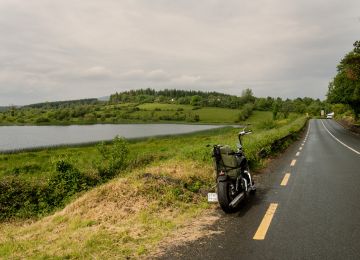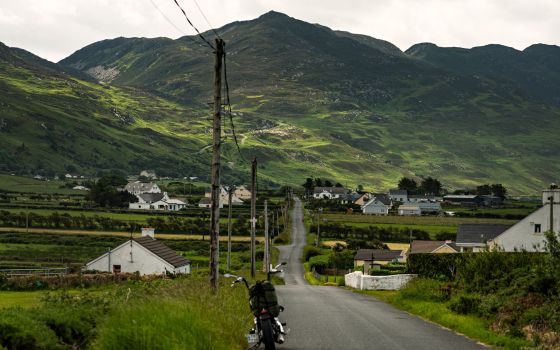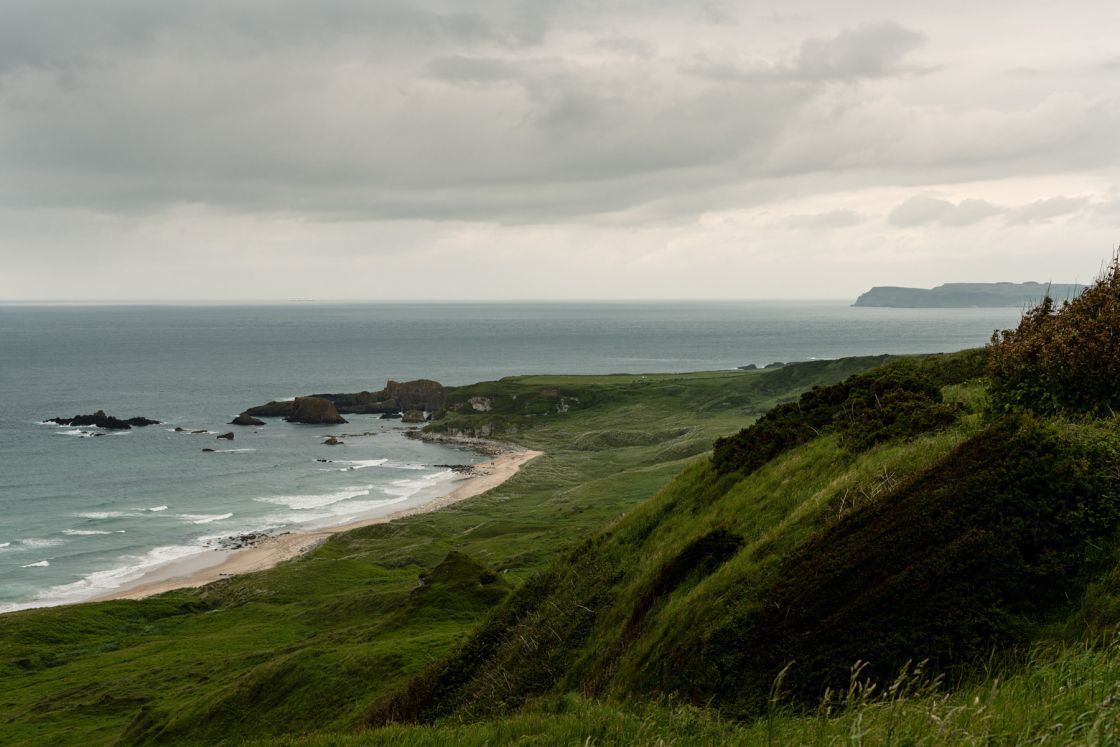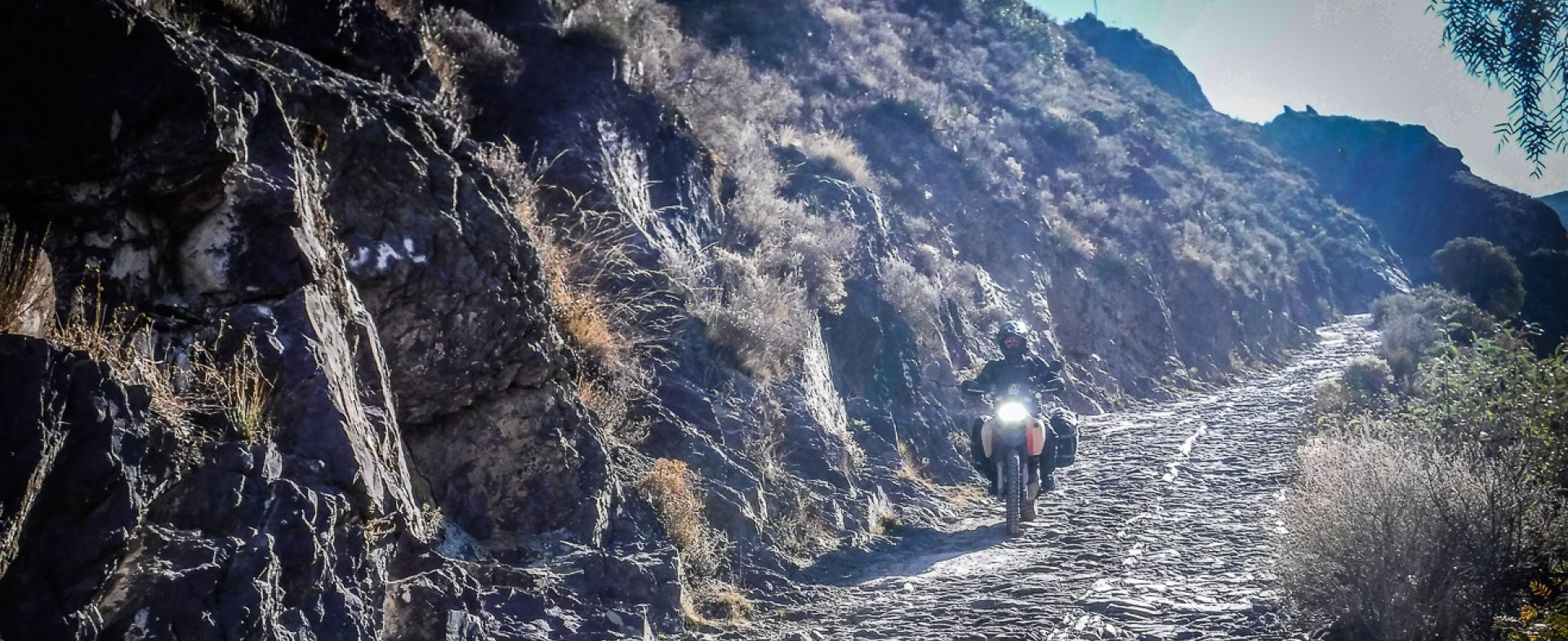Motorcycle Diaries took the long route from Sweden through Denmark, Germany, Belgium, the Netherlands, and France to catch the ferry to Ireland, seeking out what the island has to offer beyond the classic Wild Atlantic Way. Come along through magical landscapes, a spiderweb of bustling small roads, and charming distilleries—all seen from the "wrong" side of the road.
The Irish Heartland – An Adventure Through Heart and Soul
Motorcycle Diaries
Ireland. The green island with its rolling hills, black beer thick as motor oil, and driving on the "wrong" side of the road.
The landscape before me is almost too much to take in. While Ireland isn’t known for towering mountains, the coast and the terrain around the village of Leenane still command respect. The past two days have offered beautiful scenery through Ireland’s heartland, but here, the landscape suddenly turns harsh, rugged, and wild. Epic coastlines and small villages host houses so close to the sea you could practically open the kitchen window and fill the coffee pot with water. If the inland offered Ireland’s heart, this is surely its soul.
Ireland, Not an Easy Journey
Riding a motorcycle to Ireland can be both easy or hard, depending on how you see it. The simple route is to fly to Dublin and rent a motorcycle on the spot. But if, like me, you crave an adventure within the adventure, you can ride your own bike to Ireland.
The further away the bigger the adventure. This journey takes me through Denmark, Germany, Belgium, the Netherlands, and finally to Cherbourg in northern France, where you catch the ferry to Rosslare, located between Dublin and Cork. It’s about 1,900 km (1,180 miles) one way from Stockholm, offering opportunities for smaller adventures along the route.
I took the chance to ride along the northern coast of France and feel the history in Dunkirk and Calais. I even managed the timing right with the 60th anniversary of D-Day, where I saw loads of old military vehicles on the roads. On the ferry to Rosslare you can share a Guinness or two with fellow bikers and swap road stories.
Lighthouses and Distilleries
"Keep left, keep left, and drive the wrong way around the roundabout"—the words repeat in my head as I roll off the ferry in Rosslare, waving off a horde of motorcyclists also ready to explore the green island. The first destination is the 800-year-old, Hook Lighthouse, about 60 km (37 miles) west. The lighthouse is fascinating in many ways and is debated to be one of the world’s oldest, founded in the early 1200s and the second oldest functioning lighthouse in the world.
The Vikings frequently visited the area, referring to it as Vadra Fjord, or "weather mouth," during their mythical voyages.
The narrow roads wind through tiny villages and pastures, and suddenly Hook appears on the horizon, perched on the tip of a headland. It’s a scene seemingly frozen in time. Old white stone houses and the lighthouse, with its contemporary “fashion-chic” black and white stripes, stand proudly against a backdrop of a restless dark sea and heavy clouds. Just as it might have looked at the turn of the 20th century. The only thing missing is a few boats on the ocean and Irish sailors with sheep wool shirts thicker than a rear tire.
After daydreaming on the cliffs with Hook as my view, I wind my way back on the small roads. The next stop is Highbank Orchards & Distillery, Ireland’s smallest distillery, just outside Kilkenny
.Highbank began as a typical farm in the 1600s but has with time evolved into its current form. The distillery produces a mix of various products from its homegrown apples and other orchard fruits, including vinegar, syrup, juice, cider, rum, wine, brandy, and other creative infusions. The unique aspect is that the entire production is fully organic, with no chemicals sprayed on the apples, not even those allowed under the organic label, and no weed killers or artificial fertilizers used. No herbicides or artificial fertilizers are used either; nature is allowed to take its course, which provides much stronger protection against various threats. This choice is entirely unique and makes the owners, Julie and Rod, the only ones in Ireland doing this.
The results have shown positively in the harvest year after year and are reflected in the flavors. If you have any interest in food (or spirits), the former farm is well worth a visit. Julie and Rod’s genuine interest in nature and the organic approach is reflected not only in their warm welcome but also in their care for the entire environment.
On my tour of the orchard, we meet a Lithuanian woman at one of the many greenhouses on the farm. She is one of those who are allowed to use the greenhouses for free to grow vegetables and other things. The only requirement is that it must be completely organic.
The evening is spent at the family-owned but still very fancy Newpark Hotel, where I somehow managed to get a suite with a canopy bed and a jacuzzi on the balcony. This has everything a tired motorcyclist could wish for, and adding to this is the staff's understanding of motorcycles, and I get a well-lit and monitored parking spot right outside the entrance. The restaurant feels genuinely Irish with a heavy pub vibe both in decor and menu. The last hours of the day are spent in the canopy bed in front of Google Maps with the complimentary champagne guzzled straight from the bottle and an Irish coffee, or as they call it here, just coffee.
The Heartland and Irish Pub Culture
The day begins with a genuine British-style breakfast with beans, bacon, potatoes, eggs, sausage, toasted white bread, coffee, and everything else that makes your stomach increase its CO2 emissions. The first few kilometers take me through the classic Irish postcard. Between my ape hangers, the green Ireland spreads out with its characteristic fields. Small narrow roads, thought of varying quality, wind through village after village and between farms.
Eventually, everything becomes one big green blur. It’s hard to keep track of where I am or what the last village was called, but it doesn’t really matter. Getting lost, seeing where the next bend takes you, and what it looks like beyond the next hill is really the soul of motorcycle travel. If we continue with the human anatomy analogy, it’s also easy to see that this is truly the heart of Ireland. Even though only about 4% of the population works in agriculture, which accounts for just over 1% of the country’s GDP, there’s something genuine that makes this Ireland.
After seeing more views and landscapes through a green filter than I can take in, it’s time for lunch and to stretch my legs. Carrick-on-Shannon is one of those (many) picturesque and cozy Irish villages. The small village, split in half by the Shannon River, contains an art gallery, a small marina, and a seemingly very old beautiful stone bridge. Carrick-on-Shannon also has the most pubs per capita in all of Ireland.
I chose to dry my clothes from the rain shower that surprised me a few kilometers earlier—the first since I landed on the island—at the pub, The Oarsman. The pub, which has been run by the same family for seven generations, since 1781, screams Irish pub culture when you step through the doors. Dark wood, cramped spaces, more beer varieties than there are numbers, and I don’t understand a word of what’s being said through the broad accent. This is the real Ireland.
I sit in my dim corner and feel the warmth return to my body through the surprisingly well-cooked food. People come, alone or with their whole families to eat or have a pint of Guinness, greeting everyone as if they were family. Pub culture has a completely different meaning in Ireland than in Sweden. In Sweden it’s more about who can drink the biggest amount of cheap draft beer the fastest, while here it’s a common living room where people come to meet, socialize, and get the latest gossip in town.
After a tour of Carrick-on-Shannon, first on foot and then on the motorcycle, it’s time to head on towards the village of Ballyconneely for an overnight stay before Northern Ireland awaits. The road winds beautifully through old villages and along small streams and lakes. All the villages and communities I pass seem to have their own church, beautifully decorated and built like smaller versions of cathedrals.
I finally turn in through the grand gates and drive up to the roundabout that proudly sits at the entrance to the Slieve Russell Hotel Golf & Country Club. “How did I end up here?” I wonder as I park the motorcycle right across the big white letters on the ground that say, “No Parking.” You’ve got to be a bit rebellious wearing a leather jacket. If the accommodation the night before was fantastic with a jacuzzi and fuzzy bubbles, it can’t compare with this. The clientele has changed from happy families to gray-haired seniors, middle-aged golfers, and two weddings, all at once. The complex is gigantic, with more bars and restaurants than I can count, though there’s no hot tub or sparkling champagne this time.
But I enjoy a magical three-course dinner with local produce and game, recommended by the waiter herself. If the weather had been better and time allowed, I would have taken a round on the golf course just to blend in.
Malin and Northern Ireland
After breakfast it’s time to head up to Ireland’s northernmost point and what the locals call “the Wild Atlantic Ireland.”
The weather, however, has changed from somewhat pleasant to a heavy gray mush. The road quickly takes me into the southwestern parts of Northern Ireland, and just as quickly, the rain showers begin. The rain pours down with no signs of letting up. "Who am I to think I could come to Ireland for good weather?" I think as I wipe the visor clear of raindrops with soaking wet gloves.
When I reach the northernmost peninsula of County Donegal, something happens to the landscape as I follow the road that runs along the western coast. In front of my handlebars, Ireland becomes more barren, and the feeling of mountains instead of hills sets in.
In Ballyhallion, I turn sharply west, laughing to myself inside my helmet at a sign pointing to a surf school. A laugh that I quickly swallow a few kilometers later. The sea bays at Tullagh and Roxtown are, frankly, magical and perfect for surfing with their sandy beaches. My jaw drops beneath my helmet; I am so amazed by the views before me.
I continue slowly southwest, absorbing the most beautiful side of Ireland I have seen so far. Plans form in my mind to become financially independent within the next 15 minutes so I can impulsively buy one of the houses or farms lying here at the water's edge. I quickly realize that financial freedom is for people who don’t ride motorcycles, but the experiences are unique for those of us on two wheels.
After the small village of Leenan, I continue up a height that hosts the ruins of Fort Lenan, with fields full of sheep on my left and cows on my right. When I reach the top, my jaw drops further down hitting the fuel tank. The slightly restless sea, the dark clouds, and the steep green slopes flex Ireland’s green muscles to the max. I want to stay and just sit in the landscape, maybe exchange a few words with the sheep. But Malin Head, Ireland’s northernmost point, is just a few miles away, and my stomach is growling—I’ve forgotten to eat lunch again.
The weather begins to clear up, and the sun's rays of warmth are welcome. I roll into the village of Malin and decide to stop for food. After circling the square a few times, I go into the only place that seems open. Inside sits a lone man at the bar with a Guinness. I greet him, and the man responds in fluent gibberish, probably Irish or a broad local English dialect. The owner notices me, and I ask if they serve food. This man also speaks gibberish but with a hint of understandable English. I manage to catch that most places are closed, something about the EU, and that I should continue to Malin Head for food.
I take his recommendation and follow the beautiful road up to Ireland's northernmost point while smelling the sea inside my helmet. I have now passed Malin and arrived at Malin Head on my motorcycle, which goes by the name Svarta Malin (Black Malin in English) and I send a triumphant text to my fiancée, whose name you can probably guess. One would think everything was planned.
At Malin Head, the weather clears even more, and there’s no time for food. I have to experience the fantastic view available in every direction. The sea is tropical turquoise, and the experience is hypnotizing. But eventually, my stomach growls in pure desperation, and I stop at Farrens Bar, Ireland’s northernmost bar, in the village below Malin Head.
The Causeway Coastal Route
I have now reached Ireland’s northernmost point, but the journey is not over yet. I will now head back into Northern Ireland and drive what will be the most beautiful road of my life, so far. The road, which runs along the coast between Londonderry and Belfast, is 190 kilometers long but offers up to 410 kilometers of various detours if desired. If you’ve traveled The Wild Atlantic Way and made your way up along Ireland’s west coast to Malin Head, The Causeway Coastal Route is almost a natural continuation along the island’s eastern side, even if they’re not directly connected.
Fed and somewhat dry, I head southwest towards the small coastal town of Greencastle to take the car ferry over to Magilligan Point. This way, I avoid driving around the entire Lough Foyle and come straight out onto the coastline. I hadn’t done much research on The Causeway Coastal Route beyond where it was and that it was supposed to be nice to drive. I didn’t want to see too many pictures beforehand but explore and discover it for myself.
It doesn’t take many kilometers before I realize this will be something extraordinary. Besides the nature and views are straight out of a fantasy film, the weather also puts on a show. Dramatic clouds with looming rain and glimpses of sun breaking through intermittently. Even though there was nothing to complain about before, the road truly comes into its own after the small town of Coleraine.
Now I’ve come up to the heights right next to the sea coast, and the landscape and road undulate forward with steep vertical cliffs straight down into the Atlantic ocean at my left side mirror. To be completely honest—it’s hard to take in the views before me and this winding road. Since I’m arriving later in the evening, there’s very little traffic, and the spectacular weather likely helps too. Together, it creates an experience that I must classify as the most beautiful road I’ve ever driven. The road alternates between winding along the coast, turning inland, and taking me through various small valleys.
I realize that a visit of just a few hours is far from enough; you could easily spend days here just exploring the various ruins, small roads, and beaches. It’s also evident that the road has received more care than those in Ireland’s interior. The asphalt is mostly fine and smooth. The only thing I miss is more little spots to stop at, but maybe they’re there, and I’m just too hypnotized by what’s unfolding in front of my handlebars.
My last night in Ireland is spent in the small village of Moira, southwest of Belfast, at Ralph’s Hotel. A simple but very cozy hotel with beautifully decorated rooms. The hotel is named after Mr. Ralph Lutton, the first person to live at the address in the mid-1700s. Moira’s main street features classic Irish houses on one side and colorful facades on the other. After a dinner in bed, everything that can be dried is dried in preparation for the straight stretch south via Dublin to the ferry in Rosslare, and then the last little bit through five countries home.
Now that I’ve left the island and am on safe ground (even though Sweden has extradition agreements with Ireland), I can finally admit—I really don’t like Guinness!
Total kilometers in Ireland: about 1400
Total kilometers to/from Sweden: 5044
Information and GPX file
Getting there: Travel down through Europe to Cherbourg for the ferry to Rosslare. Take the opportunity to enjoy interesting sights and cities along the way, or speed down the Autobahn all the way. Alternatively, take a ferry to Great Britain, cross the country, and take another ferry from Liverpool or Fishguard over to Ireland. The easiest but most expensive option is to fly to Dublin and rent a motorcycle. This will cost you at least 200 euros per day for the motorcycle, and then you’ll need gear if you don’t bring your own, plus a plane ticket. Expect at least 1500 Euros for everything. Easy is often not cheap.
Accommodation: Depends of course on which roads you take and what you prefer. Newpark and Slieve Russel were very nice in their own ways, and it was great to just let go and be well taken care of. Ralph’s in the small community of Moira in Northern Ireland was a small and relatively cheap hotel with unique and beautiful rooms. Ireland is full of small B&Bs, and only your own wallet and geographical position set the limits.
Things to do: Besides enjoying the landscape, nature, and keeping to the left side of the road, I can highly recommend a visit to Julie and Rod’s at Highbank Orchards. Time your visit with a tour in the little train, and they also offer rooms for the night if you wish. Wander into any village, choose a pub, and enjoy the culture. If you’re in Dublin, visit the Guinness Storehouse in the city center. Malin Head is also a highlight of the journey.
Good to know: Roads in Ireland’s interior are not always the best. To be honest, they’re quite worn, although curvy in places. In the most rural areas it was sometimes tricky to find a gas pump, so keep an eye on your tank.
Extra tips: Do as I did and take the northern coast down when in France, visit Dunkirk and Calais and see as many World War II relics as you can handle. If you’re not interested in that, the vertical sloping coastal cliffs are fantastic to drive alongside.
GPX FILE HERE!
Words & Photography: Johan Stahlberg
#FORYOURRIDINGPLEASUREONLY





























